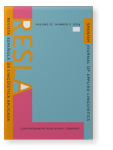Lexical bundles in Biology
Differences between textbooks and research articles
On the basis of previous lexical bundle studies, this paper examines the forms, structures and functions of 4-word bundles in a corpus of textbooks and a corpus of research articles in Biology. The study includes the main biological disciplines and focuses on three major features: the overall distribution of bundles, their typical structures, and their functions in discourse in Biology. The findings support the idea that lexical bundles are a basic linguistic construct with important functions for the construction of discourse in this area. Concluding discussion highlights the pedagogical implications of using research journals and/or textbooks to teach English to biologists in a second language context. Furthermore, the importance of explicit instruction in these word combinations in courses on English for Biologists is emphasized.
References (33)
Altenberg, B
(
1987)
Causal ordering strategies in English conversation. In
J. Monaghan (Ed.),
Grammar in the construction of texts (pp. 50–64). London: Frances Pinter.

Altenberg, B
(
1998)
On the phraseology of spoken English: The evidence of recurrent word-combinations. In
A.P. Cowie (Ed.),
Phraseology: Theory, analysis and applications (pp. 101–122). Oxford: Oxford University Press.

Altenberg, B., & Eeg-Olofsson, M
(
1990)
Phraseology in spoken English. In
J. Aarts &
W. Meijs (Eds.),
Theory and practice in corpus linguistics. (pp. 1–26). Amsterdam: Rodopi.

Biber, D., & Barbieri, F
(
2007)
Lexical bundles in university spoken and written registers.
English for Specific Purposes, 261, 263–286.


Biber, D., Conrad, S., & Cortes, V
(
2004)
If you look at….: Lexical bundles in university teaching and textbooks.
Applied Linguistics, 25(3), 371–405.


Biber, D., Johansson, S., Leech, G., Conrad, S., & Finegan, E
(
1999)
The Longman grammar of spoken and written English. London: Longman.

Biber, D., & Tracy-Ventura, N
(
2007)
Dimensions of register variation in Spanish. In
G. Parodi (Ed.),
Working with Spanish corpora (pp. 87–152). London: Continuum.

Butler, C
(
1997)
Repeated word combinations in spoken and written text: Some implications for functional grammar. In
C. Butler,
J. Connolly,
R. Gatwards, &
M. Wismans (Eds.)
A fund of ideas: Recent development in functional grammar (pp. 60–77). Amsterdam: Institute for Functional Research into Language and Language Use.

Byrd, P., & Coxhead, A
(
2010)
On the other hand: Lexical bundles in academic writing and in the teaching of EAP.
University of Sydney Papers in TESOL, 51, 31–64.

Cobb, T
n.d.)
Complete lexical tutor. Available at
[URL] [URL] on January 10, 2012.
Cortes, V
(
2004)
Lexical bundles in published and student disciplinary writing: Examples from history and biology.
English for Specific Purposes, 231, 397–423.


Chen, Y., & Baker, P
(
2010)
Lexical bundles in L1 and L2 academic writing.
Language Learning & Technology, 14(2), 30–49.

Flowerdew, J
(
1993)
Concordancing as a tool in course design.
System, 211, 231–44.


Gledhill, C
(
2000)
Collocations in science writing. Tübingen: Gunter Narr.

Howarth, P
(
1998)
Phraseology and second language proficiency.
Applied Linguistics, 191, 24–44.


Hyland, K
(
2005)
Stance and engagement: A model of interaction in academic discourse.
Discourse Studies, 7(2), 173–191.


Hyland, K
(
2008a)
Academic clusters: Text patterning in published and postgraduate writing.
International Journal of Applied Linguistics, 18(1), 41–62.


Hyland, K
(
2008b)
As can be seen: Lexical bundles and disciplinary variation.
English for Specific Purposes, 27(1), 4–21.


Jablonkai, R
(
2010)
English in the context of European integration: A corpus-driven analysis of lexical bundles in English EU documents.
English for Specific Purposes, 29(4), 253–267.


McCarthy, M., & Carter, R
(
2006)
This that and the other: Multi-word clusters in spoken English as visible patterns of interaction. In
M. McCarthy (Ed.).,
Explorations in corpus linguistics (pp. 7–26). Cambridge: Cambridge University Press.

Nation, P
(
2009)
Teaching ESL/EFL reading and writing. New York: Routledge.

O’Keeffe, A., McCarthy, M., & Carter, R
(
2007)
From corpus to classroom. Cambridge: Cambridge University Press.


Pecorari, D
(
2008)
Repeated language in academic discourse: The case of Biology background statements.
Nordic Journal of English Studies, 7(3), 9–33.


Reeves, C
(
2005)
The language of science. New York : Routledge.


Schmitt, N
(
2000)
Vocabulary in language teaching. Cambridge: Cambridge University Press.

Scott, M
(
1996)
Wordsmith tools 4. Oxford University Press.

Thompson, G
(
2001)
Interaction in academic writing: Learning to argue with the reader.
Applied Linguistics, 22(1), 58–78.


Wray, A
(
2002)
Formulaic language and the lexicon. Cambridge: Cambridge University Press.


Cited by (1)
Cited by 1 other publications
Samraj, Betty
2024.
Disciplinary differences in lexical bundles use: A cautionary tale from methodological variations.
Journal of English for Academic Purposes 70
► pp. 101399 ff.

This list is based on CrossRef data as of 16 july 2024. Please note that it may not be complete. Sources presented here have been supplied by the respective publishers.
Any errors therein should be reported to them.
